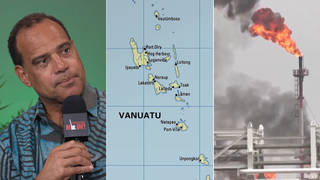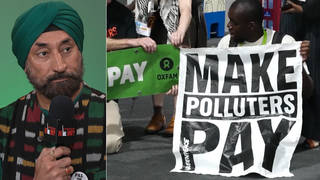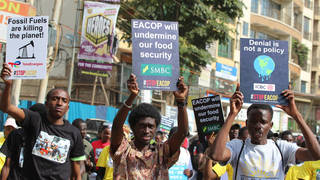
Guests
- Praful BidwaiIndian journalist and activist. He is author of the new book Politics of Climate Change and the Global Crisis: Mortgaging Our Future. He is a former senior editor at The Times of India and is a longtime peace activist. He helped found the Movement in India for Nuclear Disarmament.
We speak with Indian writer and analyst Praful Bidwai, author of the new book, “The Politics of Climate Change and the Global Crisis: Mortgaging Our Future.” While the U.S. has cited China’s emissions as an excuse to slow negotiations on reducing greenhouse gas emissions during the COP 17 talks, Bidwai says that “we cannot forget historical responsibility. Three-fourths of all the greenhouse gases that have accumulated in the atmosphere, and will stay there warming us up for thousands of years, come from developed countries of the Global North, led by the United States, which is responsible for more than one-quarter of all emissions accumulated in the atmosphere.” Bidwai also addresses the fallout from the Fukushima nuclear crisis in Japan, which he calls “a turning point” for nuclear power, adding, “I don’t see nuclear power surviving in the developed world at all after this. This is the worst crisis of credibility that the nuclear industry has ever faced.” [includes rush transcript]
Transcript
AMY GOODMAN: We’re broadcasting from Durban, South Africa, where the 17th COP is taking place. That’s Conference of Parties. A number of people outside the convention center, and even some inside, are calling it “Conference of Polluters.” It’s the U.N. conference on climate change. There are thousands of people, close to 20,000 people, who have gathered inside and outside the convention center for this two-week summit.
This is Democracy Now! I’m Amy Goodman, as we continue our show with the Indian writer and analyst Praful Bidwai. He is author of a new book called The Politics of Climate Change and the Global Crisis: Mortgaging Our Future. He’s former senior editor at The Times of India, is also a longtime peace activist. He helped found the Movement in India for Nuclear Disarmament.
From nuclear disarmament to the issue of global warming, make the connection, why this is such a critical issue for you and for India and the world.
PRAFUL BIDWAI: Well, just as during the Cold War, nuclear weapons threaten the very existence of the world. I think now we have climate change, which is the biggest threat to the survival of humanity, of humankind as—and civilization as we know it today. And so, for me, the connections have to do with survival, with fighting for a more just and humane world order, and for making for a sustainable future for all of us.
AMY GOODMAN: Can you explain the BASIC countries for people, especially in the United States, who are hardly paying attention to what’s happening here in Durban, South Africa? I mean, studies show that increasingly in the United States Americans, year after year, feel climate change increasingly is not a problem and not connected to humans, not created by humans.
PRAFUL BIDWAI: Mm-hmm. Oh, it is a serious problem, of course. It’s so grim that unless we—the world reaches a peak in its emissions of carbon dioxide and other greenhouse gases that warm the atmosphere in the next five or seven years, we will be—we’ll be locked into a very high emissions and high temperature trajectory, where the survival of the world will be jeopardized. At this present rate, where emissions pledges, all added up—made nationally, add up to something that is about 40 percent short of what we need by way of emissions reductions, if it—if global warming is to be contained to the maximum level of two degrees Celsius above pre-industrial levels.
Many scientists now believe that two degrees is far too high, 1.5 is the maximum that planet earth can tolerate. And at this present rate of emissions, we are headed for three or four or even five degrees Celsius. Now, three degrees means something, you know, that we couldn’t cross, a number of tipping points beyond which remedial action becomes futile, useless. At four degrees, according to many scientists, eminent scientists, just about a tenth of the human population will survive. It is that grim a situation. So we’ve got to act. That is the last decade now, the last chance for us. And that’s why these negotiations are being rightly called the most important negotiations ever undertaken in the history of the world.
AMY GOODMAN: The BASIC countries are Brazil, South Africa, India and China.
PRAFUL BIDWAI: That’s right.
AMY GOODMAN: The United States has continually used China as an excuse not to move forward on reducing greenhouse gas emissions—
PRAFUL BIDWAI: Right.
AMY GOODMAN: —saying that China is the worst emitter and it is not controlled under the Kyoto Protocol the way the United States is, because it’s been considered a developing country.
PRAFUL BIDWAI: Mm-hmm.
AMY GOODMAN: Talk about these countries, which includes your own, the BASIC countries, India.
PRAFUL BIDWAI: Right. The BASIC countries are indeed the fast-growing economies, emerging economies of the world, and their emissions are also growing very fast. In fact, for instance, in the past two decades, India’s emissions—South Africa’s increased at twice the global rate, India’s at four times the global rate, and China’s at five times the global rate. So they definitely are the biggest current and future emitters.
But we cannot forget historical responsibility. Three-fourths of all the greenhouse gases that have accumulated in the atmosphere, and will stay there warming us up for thousands of years, come from the developed countries of the Global North, led by the United States, right, which is responsible for more than one-quarter of all emissions accumulated in the atmosphere. So, we have to have a balance between historical responsibility and current and future responsibility. And I think the United States government is totally wrong in trying to blame China for—you know, as the biggest polluter. It is indeed today the biggest emitter, but the United States was the biggest emitter for 150 years. And those effects, which are already in the pipeline, will be felt for hundreds of years. So we have to have a principle of responsibility based upon the contribution to global warming by different countries. And here, the industrialized countries have the maximum responsibility.
But soon, the BASIC countries will also have to take on certain obligations, maybe of a different kind. And some of them have actually done so. China has, for instance, offered to reduce the emissions intensity of its economy by 40 to 45 percent by 2020. India has offered to do the same by 20 to 25 percent. The emissions, you know, thus averted, add up to something much more than what the United States and the top six, seven emitters from the developed world have committed themselves to. So I think we ought to understand that the current and future emitters belong to a different category from the historical emitters. Also, we must understand that people at—that India has a very large number of very poor people. Fifty-five percent of Indians do not have access to electricity, right? And this is a basic right, surely. And until some of these rights are fulfilled, people in these countries ought not to be asked to bear responsibility.
And here, I think we have to also look at things like—I mean, move away from nation states as the only unit in which we understand this. We need to talk about other norms or other criteria. For instance, there’s a good framework called the Greenhouse Development Rights Framework, which says, let’s draw a development threshold cutting across the countries of the world. Those who are above the development threshold don’t—you know, must bear the responsibility in proportion to their contribution to global warming. Those below the threshold should not have to bear any responsibility, whether they live in the developed countries or the developing countries. If you use that criterion, you get a much more balanced picture than what is being painted now with the bracketing of China and India together. Now, you know, China has emissions which are comparable to those of Western Europe per capita, whereas India has emissions about five times lower. So to bracket them together, it seems to me, is not very useful. Their obligations ought to be different.
But I think the United States is doing so repeatedly and blaming them as a way of avoiding and ducking its own responsibility. It talks about the Kyoto Protocol in respect of China, but it has never—it never ratified the protocol itself. Canada and Australia, which are signatories to the protocol, are going to exceed their emissions reduction targets by 30 percent or more. You know, countries like France, Italy and the Netherlands, which ought to have cut their own emissions at home, have been buying carbon credits cheap from the world market, and yet they’re not meeting their Kyoto targets. So there’s a lot of cheating by the developed world. Look, the developed countries had committed themselves in 1992 to reach a plateau in their emissions by the year 2000. And yet, today their emissions are rising. So they are in breach of their most solemn commitment under the climate convention.
AMY GOODMAN: Praful Bidwai, talk about what’s happening in the Himalayas.
PRAFUL BIDWAI: The Himalayan glaciers, which are—which feed 10 of the greatest river systems of Asia, are melting rapidly. This is going to affect something like 200 billion people who live downstream of these rivers, which get their feed water from the glaciers, including the Ganges, including the Huang He, the Yellow River, the Brahmaputra, and the Mekong, and so on and so forth. Now, this is a grim crisis. And the Himalayan glaciers are indeed melting very rapidly. There was this controversy, which—when the IPCC, the Intergovernmental Panel on Climate Change, produced an inaccurate report. In particular, one particular reference was all wrong about giving the date by which the Himalayan glaciers would disappear altogether as 2035. This was wrong. It admitted its mistake. But there’s no doubt whatsoever that the glaciers are melting very rapidly, and we have to act, you know, in the next few years to prevent that rate from accelerating and then stabilize the atmosphere there.
AMY GOODMAN: We just had a headline today on Fukushima. You’re a leading anti-nuclear activist in the world. Often nuclear power is held up as a kind of clean energy, the way it first was after the dropping of the atomic bomb.
PRAFUL BIDWAI: Right.
AMY GOODMAN: President Obama is promising to have built several nuclear power plants, which have not been built in decades in the United States.
PRAFUL BIDWAI: Right.
AMY GOODMAN: The headline we had was radioactive water is leaking into the Pacific Ocean. What about Fukushima—and you write about this in your book—and the bleak power of nuclear—the bleak future of nuclear power—
PRAFUL BIDWAI: Right.
AMY GOODMAN: —after it?
PRAFUL BIDWAI: I think Fukushima is a turning point. I don’t see nuclear power surviving in the developed world at all after this. This is the worst crisis of credibility that the nuclear industry has ever faced. The fact that it could happen in an extremely developed and highly skilled country like Japan means that we ought to be really, really afraid of similar accidents happening. And we know from engineers and operators and designers of nuclear plants that such a meltdown accident of the kind that took place at Three Mile Island in 1979 in the United States or Chernobyl in the Ukraine could happen in any of the existing reactor types in the world. There are 400 of them. So the probability of such an accident occurring is disturbingly high, maybe one meltdown every eight years. And that’s simply unacceptable, because the damage this would cause—and let me give you just one number. There’s a study from Germany which shows that the damage would be on the order of $11 trillion, which is more than the national income of Germany, right? That’s the kind of damage we are talking about. It would wipe out the third largest economy in the world, right? So that’s the kind of meltdown that could happen anywhere.
There is also the problem of waste and of radiation at every exposure at every stage of the so-called nuclear fuel cycle. Besides, nuclear power has turned out to be far more expensive than ever imagined. It’s about—its costs have risen five times in the past decade. And I think this is not the way forward. I tried to show in my book that in fact even the claim that nuclear power is cleaner than many other—than renewable resources is fundamentally wrong. It’s simply not true. The carbon abatement potential of renewable resources is far, far superior to that of nuclear power. Nuclear power has lifetime costs because, although nuclear plants don’t directly produce carbon dioxide, the construction of these plants, right in fact—right from the uranium mining stage to the waste storage and disposal—or waste storage, I mean, there’s no disposal—you have a strong carbon footprint. So it does add up to a very substantial carbon footprint, on the whole. Over a lifetime cycle, it varies. Biomass, solar, small hydro and wind are far, far superior in this respect.












Media Options